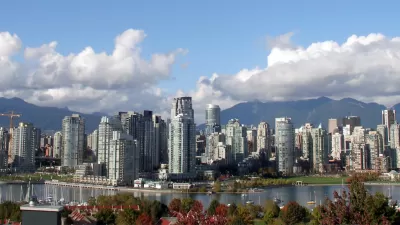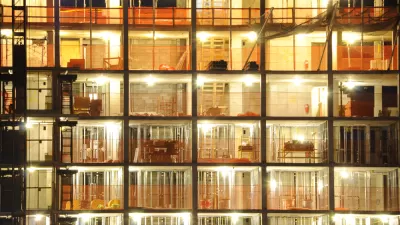Some progressives deny that the law of supply and demand applies to housing.

Progressives often argue that conservatives are anti-science because many conservatives deny the reality and seriousness of climate change, and some religious conservatives reject the theory of evolution.
But some people (mostly progressives, it seems to me) are as skeptical of the conventional wisdom of economics as conservatives are of evolutionary biology or climate science. In particular, one basic tenet of economics is the law of supply and demand: if you raise the supply of X enough, the prices go down. If you lower the supply, the prices go up.
But some progressives seem to believe that this law does not apply to housing. For example, an article some months ago in the New York Times (probably the most leftist among major U.S. news sources) quoted an official at an affordable housing advocacy group as follows: "Increasing the supply is not going to increase the number of affordable units; that is a complete and utter fallacy." The Times then supplied absolutely no rebuttal or response to this point of view, implicitly treating it as gospel.* Similarly, numerous leftist housing advocates in San Francisco are supply-and-demand denialists.
In reality, cities where lots of housing gets built tend to have lower housing prices than cities where it is hard to build. (See for example the "Home Prices and New Construction" chart in this article). So why is denialism so widespread? Denialists make several major arguments.
Argument 1: "There already has been a building boom in New York and San Francisco, and what good has it done?" In reality, expensive cities tend not to have very much new housing at all. For example, one document claimed proudly that the laws of supply and demand did not apply to San Francisco because there were "2,730 new [housing] units in 2003... and 3,360 new units in 2009.".
But that city's population increased by about 130,000 between 1980 and 2010, which means that even if the city had allowed 3,000 new units every year as in 2003 or 2009, and even if household sizes and city income had remained constant, housing production would lag behind population growth; there would have been 90,000 new housing units and 130,000 new people. But this was not the case; the same document concedes that 2003, 2008 and 2009 were the "three most productive years of housing development" in the past 45 years.
In fact, only about 68,000 new housing units have been built since 1980. So what really happened was that housing supply grew far less rapidly than population, and the tech boom meant that the population had more money to spend (i.e., that demand increased by more than population). The theory of supply and demand suggests higher housing prices, which, of course, is what happened.
Housing construction in other high-cost cities has declined over time. In high-cost Los Angeles, the number of new housing units permitted by government has nosedived over the past 30 years, from about 6,000 per year in the 1980s to about 1,000-2,000 in the 2010s. Similarly, in Manhattan the city permitted 11,000 units per year between 1955 and 1964, and less than one-third that many during the 1980s and 1990s. Over the past decade, New York never equalled its 1950s and 1960s level; the number of residential permits in Manhattan ranged from 903 in 2010 to 9700 in 2008. (The 2004-13 average, if I have calculated correctly, is about 5300 per year- still far below the 1950s peak.)
Argument 2: "demand for urban life as unlimited, and thus no amount of new housing will affect rents." I might take this argument more seriously if population in New York and San Francisco was growing faster than in low-cost cities. In fact, many low-cost cities are growing far more rapidly than New York, and yet have cheaper rents. Between 2000 and 2010, the population of metro Austin grew 37 percent, and that of Raleigh 41 percent. By contrast, the population of metro New York grew 3 percent, and that of San Francisco 5 percent. Even if we look only at urban population, we see higher population growth in low-cost cities: Austin and Raleigh grew by 20 and 46 percent respectively, while New York and San Francisco's urban growth kept pace with metropolitan growth. (Though to be fair, income growth in the latter cities probably means that demand for housing grew more rapidly than 3-5 percent).
Moreover, a surge in new housing can occasionally cause rents to go down even in high-cost cities: in Washington, D.C., a surge of new construction has caused rent growth to flatten out.
Argument 3: "the problem of high market-rate rents is insoluble, because more building means more density, denser buildings are taller, and taller buildings are inherently more expensive." First of all, it is sometimes possible to create plenty of density without high-rises: there are plenty of dense, low-rise neighborhoods like NYC’s West Village.**
Moreover, height and high costs are not linked so closely as one might think. I concede for the sake of argument that taller buildings may have higher construction costs. However, it seems to me that the cost of land (which is a result of government regulation rather than a result of nature, since government effectively reduces the supply of land by limiting building) is often more significant than the cost of construction.
How so? Because if the cost of building a few extra stories was the major factor governing housing costs, low-rise buildings would be cheap even in high-cost cities, and high-rises would be expensive even in low-rise cities. But in fact, this is not the case. I ran a search for doorman buildings on Craigslist (using "doorman" as a surrogate for "high-rise") in low-cost St. Louis; I found dozens of studios and one-bedrooms for under $1000, including one for only $500. By contrast, in San Francisco, the only units available for under $1000 involved furnished rooms, and the cheapest doorman building cost a little over $2400. Height may affect cost—but not very much.
One might argue that I should only have looked at newer buildings, since the cost of construction was much lower a few decades ago. Using streeteasy.com, I verified this assertion by looking at studio and one-bedroom units in Manhattan in doorman buildings over 10 stories built after 2010. The cheapest building, in Harlem, was only $2000 (only $300 more than in the cheapest new walk-up in Manhattan). This fact suggests that even in New York, a new high-rise building does not have to be super-expensive merely because of its height (even with the added labor cost of a doorman). Instead, the $2000 building was cheaper because of its location (Harlem)—in other words, because of low demand.
Argument 4: "New housing creates demand which increases prices; thus, new housing can never reduce prices." To be fair, this argument is not silly on a neighborhood-by-neighborhood level: if new construction or renovation of existing housing means that you can live in neighborhood X while living in a nicer place, neighborhood X becomes more popular.
But I am not sure induced demand matters as much on a citywide level; the people moving to neighborhood X will often be likely to be moving from another city neighborhood (thus lowering demand for the latter area). Moreover, the induced demand theory fails to explain why some high-supply markets are actually less expensive than New York or San Francisco. If high supply inevitably led to high demand, then high-growth cities would all be among the most expensive cities—which of course is not the case. (For example, the median studio in Austin rents for $738, which doesn't get you very far in New York.)
In sum, the arguments for supply-and-demand denialism simply lack merit. So what? Why does this matter? Just as a place where climate change denialism is rampant is likely to adopt anti-environmental policies, a city pockmarked with supply-and-demand denialism is likely to adopt anti-supply policies such as restrictive zoning and laws that discourage people from becoming landlords (such as laws that make it hard to evict tenants).
*In fairness, it may be that the person who was being quoted meant "affordable housing" as a technical buzz-word meaning "government-subsidized housing for the poor" rather than in the commonsense meaning of the term (i.e. housing that most people can afford). But in context I don't think that the Times reporter understood it that way, nor do I think that most of the Times's readers understood it that way.
**However, I do not think this possibility is a legitimate excuse for height limits. Here's why: building 100 low-rise units will normally require more land than building 100 high-rise units, which in turn means that more homeowners will have to live near apartments, which of course is something that homeowners tend to dislike. As a result, it seems to me that reproducing Greenwich Village may be even more politically impossible than building more high-rises.

Trump Administration Could Effectively End Housing Voucher Program
Federal officials are eyeing major cuts to the Section 8 program that helps millions of low-income households pay rent.

Planetizen Federal Action Tracker
A weekly monitor of how Trump’s orders and actions are impacting planners and planning in America.

The 120 Year Old Tiny Home Villages That Sheltered San Francisco’s Earthquake Refugees
More than a century ago, San Francisco mobilized to house thousands of residents displaced by the 1906 earthquake. Could their strategy offer a model for the present?

HSR Reaches Key Settlement in Northern California City
The state’s high-speed rail authority reached an agreement with Millbrae, a key city on the train’s proposed route to San Francisco.

Washington State Legislature Passes Parking Reform Bill
A bill that would limit parking requirements for new developments is headed to the governor’s desk.

Missouri Law Would Ban Protections for Housing Voucher Users
A state law seeks to overturn source-of-income discrimination bans passed by several Missouri cities.
Urban Design for Planners 1: Software Tools
This six-course series explores essential urban design concepts using open source software and equips planners with the tools they need to participate fully in the urban design process.
Planning for Universal Design
Learn the tools for implementing Universal Design in planning regulations.
Ada County Highway District
Clanton & Associates, Inc.
Jessamine County Fiscal Court
Institute for Housing and Urban Development Studies (IHS)
City of Grandview
Harvard GSD Executive Education
Toledo-Lucas County Plan Commissions
Salt Lake City
NYU Wagner Graduate School of Public Service






























